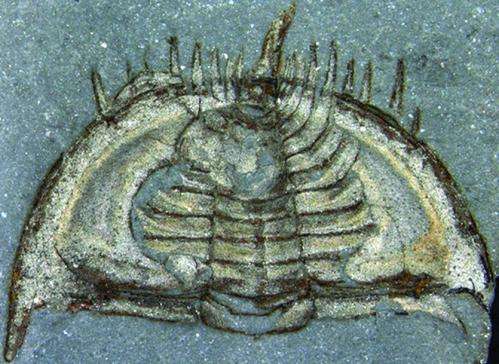September 25, 2013 report
New evidence suggests earliest trilobites were able to partially roll up their bodies

(Phys.org) —A trio of researchers—two from Cambridge University and one from the Chinese Academy of Sciences, has found evidence that suggests that the earliest trilobites were able to roll up their bodies for protection, much as their later ancestors did. In their paper published in the journal Biology Letters, the team describes their examination of a fossil found in Alberta Canada, and how they ruled out other causes for its rolled up position.
Trilobites were simple organisms that came into existence approximately half a billion years ago. They evolved over another 250 million years before eventually going extinct. During their time on Earth, they left behind many fossils which scientists have been studying for years. One facet of their development that has fascinated researchers is that the more recent versions of the organism were found to curl themselves into a ball to protect themselves from bad weather or predators—much like modern pill bugs. Early trilobite fossils showed no such ability. Now however, it appears that even the very earliest trilobites were able to curl up to protect themselves, but their mechanism was far less robust.
When modern pill bugs, and later trilobites curl up, their anatomy allows for them to remain curled up without effort. That's why their bodies remain curled up even after the organism has died. This does not appear to be the case for earlier trilobites, however, which had to use their muscles to keep curled. This is why, the researchers explain, examples of curling up by early trilobites had never been found before.
The trilobite analyzed in the study was found in Jasper National Park in Canada. Prior research had dated it to the Cambrian Period—the time during which life all over the planet was greatly diversifying—in this case, to approximately 513 million years ago. The specimen was part of a larger group, but it stood out as it was folded over with its tail spines in front of its head. Their interest aroused, the researchers looked closer and after much study concluded that the trilobite had not simply been squashed into its position, but had folded itself over intentionally, likely, like its later ancestors, to protect itself.

The discovery creates a link between more modern easy-folding trilobites and their early ancestral behavior, providing scientists with an excellent example of evolution in action.
More information: Humble origins for a successful strategy: complete enrolment in early Cambrian olenellid trilobites, Published 25 September 2013. DOI: 10.1098/rsbl.2013.0679
Abstract
Trilobites are typified by the behavioural and morphological ability to enrol their bodies, most probably as a defence mechanism against adverse environmental conditions or predators. Although most trilobites could enrol at least partially, there is uncertainty about whether olenellids—among the most phylogenetically and stratigraphically basal representatives—could perform this behaviour because of their poorly caudalized trunk and scarcity of coaptative devices. Here, we report complete—but not encapsulating—enrolment for the olenellid genus Mummaspis from the early Cambrian Mural Formation in Alberta, the earliest direct evidence of this strategy in the fossil record of polymerid trilobites. Complete enrolment in olenellids was achieved through a combination of ancestral morphological features, and thus provides new information on the character polarity associated with this key trilobite adaptation.
Journal information: Biology Letters
© 2013 Phys.org



















